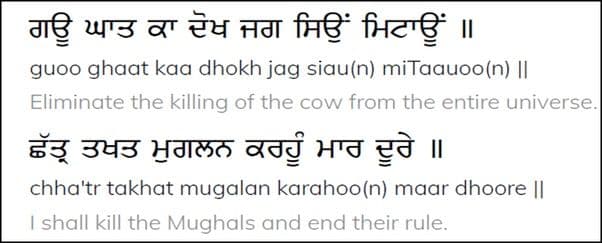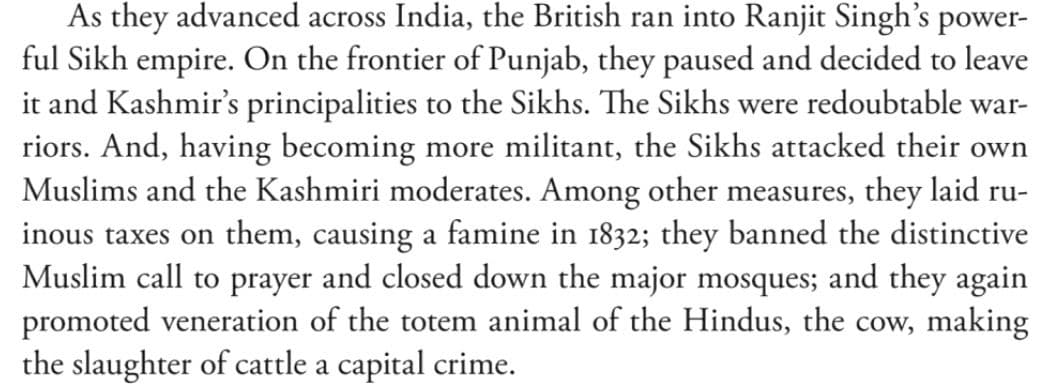Sikhi and Cow
Oogardanti Baani of Guru Gobind Singh, as included in the Dasam Granth, speaks of cow killing as a sin. Guru Gobind Singh has written that:

“Give me this command that I may grab Turks and destroy them. The great evil of cow-killing may I stop in this world. The throne of the Mughals may I destroy”
“Fulfil this desire of mine. May the suffering of cows stop. May the victory of the true Guru resound throughout the world.
However, it may be reasoned that the name ‘cow’ used by Guru Gobind Singh is a reference to the weak, like cows, a defenseless and peaceful beast. Whilst the regime, at the time, is referred to as the cow-killer – “gau ghaat” …
There is no universal agreement on how Guru Arjan Dev Ji died. However, everyone agrees that he was tortured and killed by the Mughals for not converting to Islam. One narration states that after killing him by boiling him alive, he was returned in a cowhide. Another narration states that Jahangir tortured Guru Arjan Dev by making him sit on a hot pan, and hot sand was poured over him, Guru ji did not flinch an iota and continued to face the torture in silence and peaceful composure. But when Jahangir decided to take the torture to another level and ordered that a freshly slaughtered cowhide wrap Guru Arjan Dev ji, Guruji requested Jahangir to allow him a bath first. Jahangir relented to the request. Guruji entered the river Ravi and never came out of it by merging with the Almighty. It was obvious that Guruji preferred to merge with the Almighty rather than face the humiliation of being wrapped with a slaughtered cowhide, and this incident depicts how a cow was held in great sanctity by Guruji during his times. Source: Page 254 of History of Punjab by Syed Muhammad Latif.
Jassa Singh Ahluwalia took up arms to kill cow butchers several times, Giani Gian Singh speaks of the actions of Jassa Singh Ahluwalia as: “Though, he was very against the killing of cows. To stop this, he attacked many times Lahore and Kasur, and slayed the cow butchers.” - Twarikh Guru Khalsa, Giani Gian Singh (1894), Pa 734
Source: https://kulveersamra.wordpress.com/2017/05/31/cow-slaughter-and-sikhism/
In the subsequent years following the assassination of Banda Singh Bahadur, when Abdali was angered at the massacre of his troops by Sikhs, in retribution he attacked Sri Harmandir Sahib in Amritsar and blew it with gunpowder. And he desecrated the holy Sarovar with slaughtered cow carcasses. Later, Massa Rangar committed a similar sacrilege, and apart from the desecration of the holy Sarovar with slaughtered cows, he also made sex workers dance and sing in the premises of Sri Harmandir Sahib. However, this time, he was duly punished by Mahtab Singh and Sukha Singh, who swiftly beheaded Massa Rangar in Sri Harmandir Sahib.
Source: Page 102 of History of the Sikhs by Kushwant Singh
Therefore, it was at least obvious to the Mughals of those times that the massacre of cows would seriously hurt the sentiments of Sikhs.
Maharaja Ranjit Singh has been an example of the zenith of the Sikh empire that broke off the shackles of slavery of North Indian Hindu-Sikhs from the Afghans and Mughals, who were bent on establishing Islam in India to replace Hinduism. And during the rule of the Maharaja, beef eating and cow slaughter were prohibited. This was although the population of the areas ruled by the Maharaja included a Muslim population over 55%. Source: Page 263 of Crusade and Jihad: The Thousand-year War Between the Muslim World and the Global North

“In 1871 when the then appointed Deputy commissioner of Amritsar gave an open permission to the Muslims for running cow slaughter houses. This was a deliberate act by the Muslims and the British to hurt the feeling of the Sikhs and the Hindus. When the Namdhari Sikhs retaliated against this decision five of them were hanged without any trial.” - source.
Bhai Gurdas, the scribe of Guru Granth Sahib, said “cow dung, cow’s urine, and silk are considered sacred…”
In some English translations, this is translated as “According to Hindu mythology, cow dung and cow’s urine are considered sacred…” Even though the original Gurmukhi wordings do not contain or mention “According to Hindu mythology” anywhere.
Source: https://www.igurbani.com/shabad/42203
Some portions of this post were taken from here.